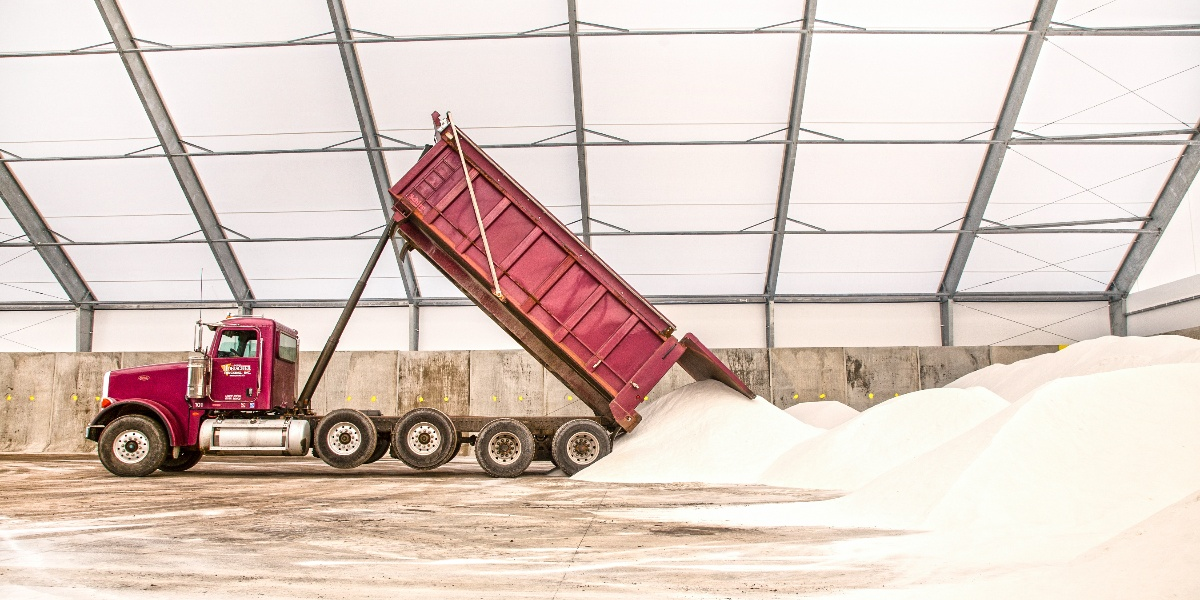Lyons Salt: A Case Study in corrosion protection

Corrosion is the deterioration of metal caused by a reaction with the environment. It is estimated that corrosion costs billions of dollars in repair, replacement and lost time every year.
Corrosion happens every day in every industry. However, certain elements – including water, salt and chemicals – speed up the rate of corrosion. Anyone involved in working with corrosive elements or in corrosive environments focuses on minimizing rust and other damage to the metal. Storage buildings are one example of an asset that may be damaged by corrosion.
Lyons Salt, a salt mining operation in Kansas, is an example of a company that deals with the threat of corrosion every day. Recently, one of their main storage buildings – just 10 years old – was threatened with severe degradation and required replacement. They knew from previous experience that a fabric structure was the right general building type. And because the open web trusses and secondary framing members were most severely damaged by the corrosion, Lyons knew they needed another framing option.
After consulting with Legacy Building Solutions, Lyons chose a fabric structure on a hot dip galvanized rigid steel frame. The solid frame has no unseen areas for corrosion to begin, and the steel is several times thicker – and sturdier – than it is on a hollow tube frame. But because the building would be dealing with highly corrosive salt and fine salt dust on a daily basis, they required some additional anti-corrosion measures.
- Interior liner: A fabric liner is securely attached to the bottom flange of the building frame. The liner acts as a barrier between the salt and the steel building frame. Lyons chose a clear liner to maximize the light penetration inside the building. The liner is also doubled near the bottom of the structure, where the salt piles are located.
- Steel bracing rods: One area that concerned Lyons was the bracing cables used in the old building. Salt had collected between the threads of the cables, causing them to corrode and snap. The new building uses 5/8-inch steel rods for bracing. The solid steel rods have no hollow areas or indentations for corrosion to start, and they are made of galvanized metal for further protection. These thick rods are significantly less vulnerable to corrosion than cables.
- Purlin caps: Salt dust can enter through the open ends of the hollow purlins and settle inside the tube. The old-school way of solving this problem is by smashing the end of the purlin and attaching it to the building frame. The problem is that smashing the end of the purlin compromises the integrity of the framing member. Legacy’s solution to this problem was adding caps to the end of each purlin, preventing dust from entering the hollow tube without compromising the strength of the member.
- Ventilation: Moisture is a common cause of corrosion. Proper aeration and air circulation around the building not only keeps a comfortable temperature inside the building, it also protects the frames from corrosion caused by dampness or condensation inside the building – particularly important in structures with crawl spaces, insulation or cavities. The building in Lyons has separate gravity ventilation systems for the building interior and the cavity created by the liner.
- Double coated steel: The steel used to support the conveyor is necessarily outside the liner. In addition to the hot dip galvanizing, this steel was coated with an epoxy for extra protection from corrosion. This epoxy coating protected the unlined steel and ensures that the conveyor support system lasts as long as the building supporting it.
Want to know more? Watch this time-lapse video of the fabric structure's construction.
Ready to get started with your own corrosion-inert building? Request a consultation today.
Frequently Asked Questions
Corrosion is the deterioration of metal caused by reactions with environmental elements like water, salt, and chemicals. It leads to costly repairs, replacements, and downtime, making it a major concern for industries that rely on steel structures.
Lyons Salt’s old storage building, only 10 years old, had severe damage to open web trusses and secondary framing members due to constant exposure to salt and fine salt dust. This degradation required a replacement building designed to withstand a corrosive environment.
A hot dip galvanized rigid steel frame provides solid, thick steel members with no hidden cavities where corrosion can start. The galvanizing adds an extra layer of protection, making it far more resistant to rust compared to hollow tube frames.
Legacy added multiple protective features, including:
-
A clear interior liner to shield the frame from salt while allowing light in.
-
Galvanized solid steel bracing rods instead of cables.
-
Purlin caps to keep salt dust out of hollow tubes.
-
Separate ventilation systems for better air circulation.
-
Epoxy-coated steel on conveyor supports for extra durability.
Proper ventilation reduces moisture and condensation, which are major causes of corrosion. In the Lyons Salt building, separate gravity ventilation systems for the liner cavity and building interior help maintain airflow and protect the steel from dampness.
For steel components outside the protective liner, epoxy coating provides a second barrier against corrosion. Combined with galvanizing, this double protection ensures long-term durability in highly corrosive environments.
Subscribe to our Blog
Recent Posts
- 5 Factors Every Project Owner Should Consider Before Approving Building Materials
- The 20-Year View: How Material Choices Impact Long-Term Operational Costs
- Climate Resilience in Commercial Construction: Why Traditional Methods May Not Be Enough
- Speed and Quality: The Role of Hybrid Building Materials
- Beyond the Bleachers: Designing Visually Striking Sports Facilities
